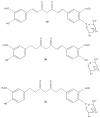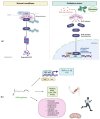Phytochemicals in Skeletal Muscle Health: Effects of Curcumin (from Curcuma longa Linn) and Sulforaphane (from Brassicaceae) on Muscle Function, Recovery and Therapy of Muscle Atrophy
- PMID: 36235384
- PMCID: PMC9573421
- DOI: 10.3390/plants11192517
Phytochemicals in Skeletal Muscle Health: Effects of Curcumin (from Curcuma longa Linn) and Sulforaphane (from Brassicaceae) on Muscle Function, Recovery and Therapy of Muscle Atrophy
Abstract
The mobility of the human body depends on, among other things, muscle health, which can be affected by several situations, such as aging, increased oxidative stress, malnutrition, cancer, and the lack or excess of physical exercise, among others. Genetic, metabolic, hormonal, and nutritional factors are intricately involved in maintaining the balance that allows proper muscle function and fiber recovery; therefore, the breakdown of the balance among these elements can trigger muscle atrophy. The study from the nutrigenomic perspective of nutritional factors has drawn wide attention recently; one of these is the use of certain compounds derived from foods and plants known as phytochemicals, to which various biological activities have been described and attributed in terms of benefiting health in many respects. This work addresses the effect that the phytochemicals curcumin from Curcuma longa Linn and sulforaphane from Brassicaceae species have shown to exert on muscle function, recovery, and the prevention of muscle atrophy, and describes the impact on muscle health in general. In the same manner, there are future perspectives in research on novel compounds as potential agents in the prevention or treatment of medical conditions that affect muscle health.
Keywords: curcumin; phytochemicals; skeletal muscle; sulforaphane.
Conflict of interest statement
The authors declare no conflict of interest.
Figures





Similar articles
-
Molecular targets for the management of cancer using Curcuma longa Linn. phytoconstituents: A Review.Biomed Pharmacother. 2021 Mar;135:111078. doi: 10.1016/j.biopha.2020.111078. Epub 2021 Feb 1. Biomed Pharmacother. 2021. PMID: 33433356 Review.
-
Ethnobotany, Phytochemistry and Traditional Uses of Curcuma spp. and Pharmacological Profile of Two Important Species (C. longa and C. zedoaria): A Review.Curr Pharm Des. 2019;25(8):871-935. doi: 10.2174/1381612825666190402163940. Curr Pharm Des. 2019. PMID: 30947655 Review.
-
Changes in urinary metabolic profile after oral administration of curcuma extract in rats.J Pharm Biomed Anal. 2014 Nov;100:348-356. doi: 10.1016/j.jpba.2014.07.035. Epub 2014 Aug 12. J Pharm Biomed Anal. 2014. PMID: 25200426
-
The effects of Curcuma longa and curcumin on reproductive systems.Endocr Regul. 2017 Oct 26;51(4):220-228. doi: 10.1515/enr-2017-0024. Endocr Regul. 2017. PMID: 29232190 Review.
-
Curcuma longa Linn. extract and curcumin protect CYP 2E1 enzymatic activity against mercuric chloride-induced hepatotoxicity and oxidative stress: A protective approach.Exp Toxicol Pathol. 2017 Jul 5;69(6):373-382. doi: 10.1016/j.etp.2017.02.009. Epub 2017 Mar 21. Exp Toxicol Pathol. 2017. PMID: 28336172
Cited by
-
Sulforaphane enhanced muscle growth by promoting lipid oxidation through modulating key signaling pathways.Biosci Rep. 2024 Jul 31;44(7):BSR20240084. doi: 10.1042/BSR20240084. Biosci Rep. 2024. PMID: 38868980 Free PMC article.
-
Developing multifunctional crops by engineering Brassicaceae glucosinolate pathways.Plant Commun. 2023 Jul 10;4(4):100565. doi: 10.1016/j.xplc.2023.100565. Epub 2023 Feb 23. Plant Commun. 2023. PMID: 36823985 Free PMC article. Review.
-
Plant-Derived Treatments for Different Types of Muscle Atrophy.Phytother Res. 2025 Feb;39(2):1107-1138. doi: 10.1002/ptr.8420. Epub 2025 Jan 2. Phytother Res. 2025. PMID: 39743857 Free PMC article. Review.
-
Curcumin: a potential anti-photoaging agent.Front Pharmacol. 2025 May 6;16:1559032. doi: 10.3389/fphar.2025.1559032. eCollection 2025. Front Pharmacol. 2025. PMID: 40395726 Free PMC article. Review.
-
Effects of Maillard Reaction Products on Skeletal Muscle Cells: An In Vitro Study Using C2C12 Myotubes.Metabolites. 2025 May 8;15(5):316. doi: 10.3390/metabo15050316. Metabolites. 2025. PMID: 40422892 Free PMC article.
References
Publication types
LinkOut - more resources
Full Text Sources

